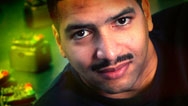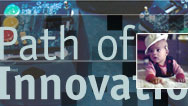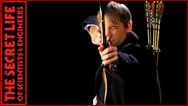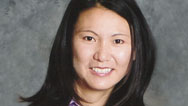Profile: James McLurkin
- Posted 01.25.05
- NOVA scienceNOW
(This video is no longer available for streaming.) James McLurkin is an award-winning robotics engineer who gets inspiration from an unlikely source: his ant farm. Each ant is a simple creature with simple rules governing its behavior, yet the colony as a whole performs complex tasks—a lesson McLurkin has adapted to develop a swarm of disposable robots for the Defense Advanced Research Projects Agency. Meet the man—and his ants—in this video.
Transcript
Profile: James Mclurkin
PBS air date: January 25, 2005
Now I want you to meet somebody who is...well, he is what he is.
And what he is, is—and you'll see this in the way he plays, the way he works, the way he loves, even the way he does his laundry—the man is an engineer, and such an engineer that if you were to look deep into his cells, down to the DNA where the rest of us have AAs and CCs and TTs and GGs he has, I haven't seen this, but I'm sure it's true, he has E-N-G-I-N-E-E-R.
With him, it's genetic as you're about to see.
JAMES MCLURKIN: All right, let's, let's get this going.
ROBERT KRULWICH: James McLurkin does not waste time.
JAMES MCLURKIN: I want to sit next to you, Dara.
ROBERT KRULWICH: Just ask his girlfriend, Dara.
DARA BOURNE (James McLurkin's Girlfriend): James said to me, when we went out to dinner the first time, "I'm a geek."
JAMES MCLURKIN: It's very important to remember that I am a geek, that I build robots and I like it. I've got pet ants. I play video games.
ROBERT KRULWICH: At only 20, he built what was then one of the world's smallest self-contained autonomous robots. Later, he won the $30,000 Lemelson-M.I.T. prize for remarkable inventiveness. His work's been exhibited at the Smithsonian, and that's just for starters.
He was Senior Lead Research Scientist at a major robotics company. He's getting his Ph.D. at M.I.T.'s Computer Science and Artificial Intelligence Lab. He teaches high school students, he's got the girlfriend. James is a very, very busy guy. But it's no sweat.
JAMES MCLURKIN: I am overheating.
ROBERT KRULWICH: Well, it's a little sweat.
JAMES MCLURKIN: I have four minutes before my next meeting.
ROBERT KRULWICH: But not to worry, he says he can do it all and have it all because he has a system.
JAMES MCLURKIN: Off we go. Time. Time.
ROBERT KRULWICH: Time?
JAMES MCLURKIN: Time.
ROBERT KRULWICH: Time
JAMES MCLURKIN: Time.
ROBERT KRULWICH: Yeah, we got it.
He is an engineer. He loves planning and systems analysis, so he has analyzed and planned every minute of his life.
JAMES MCLURKIN: Time is a resource that is more precious than any other resource I've got.
ROBERT KRULWICH: And he's determined to use that time efficiently.
JAMES MCLURKIN: I need to account for all 168 hours in the week. Every minute needs to be spent either working, sleeping or playing.
ROBERT KRULWICH: For example, driving. His rule is to commute in off-hours, when traffic is light, to save time. And don't tie your shoes at home; that's what red lights are for.
JAMES MCLURKIN: There's always time at the red lights to tie your shoes.
ROBERT KRULWICH: Lunch? It saves time to eat during class, not before, not after.
Very admirable, but, says his girlfriend, it doesn't work, he's always late.
DARA BOURNE: James always thinks he has more time than he really does. Or he thinks that—I don't know what it is—he knows better. But the schedule, the schedule's going to work. But it doesn't. And before you know it, you know, you're two hours off. Oh, man. You don't schedule properly.
JAMES MCLURKIN: I mean, it's very well scheduled. It's just...
DARA BOURNE: No it's not.
JAMES MCLURKIN: No, no, very, it's very, very precise. It's a serious, intense schedule.
DARA BOURNE: And it's never...
JAMES MCLURKIN: Too much of it.
DARA BOURNE: And it doesn't ever go according to the times that are here.
JAMES MCLURKIN: It does, sometimes, except the events that...right before I see you.
DARA BOURNE: Those ones? Just those ones?
JAMES MCLURKIN: All those pre-Dara events.
DARA BOURNE: Mmmmm.
ROBERT KRULWICH: If he's late, he says it's the system that needs adjusting. So he adjusts the system. Take laundry for example.
JAMES MCLURKIN: Laundry takes a lot of time to get the clothes into a pile, to get them in front of the machine. Moving the basket around costs 10, 15 seconds.
ROBERT KRULWICH: So James decided it was inefficient to do laundry many times a month. His solution...
JAMES MCLURKIN: What you want to do is you want to buy enough clothes that you can wait.
ROBERT KRULWICH: He calculated that he needed exactly six weeks of clothing and then on one big laundry night, he cleans everything. This is what you'd call a system adjustment.
There are always system adjustments, for example: his robots.
JAMES MCLURKIN: The most important thing to remember about robots is that they are profoundly stupid.
ROBERT KRULWICH: So he has a plan. If one robot's got almost no intelligence you add more robots, you get a little more intelligence. Lots of robots, you might even be smart.
JAMES MCLURKIN: I'm trying to figure out how you can program a thousand robots to work together to solve a common task.
ROBERT KRULWICH: So, in this case, he's given 24 robots a simple set of rules in computer code. They will start signaling each other, and without any further direction from him, they should spontaneously perform the theme song from Star Wars. But each of these robots can only play part of the song, only part. If this program works, robots here, who are Part A robots, will gather and play together.
Here we go.
That's our cameraman there on the left.
And now they are gathering in groups: Part A robots and Part B robots, and here we go. The prelude...and the theme...uh oh, it looks like they've gotten stuck.
JAMES MCLURKIN: Failure is key to any learning, creative process. Anything that you're doing, you must fail. If you do not fail, either you were lucky...Well, actually, no, that was it.
ROBERT KRULWICH: But if you're going to fail, you do need to bounce back, and James learned from early on that giving up is not a way to solve your problems.
JAMES MCLURKIN: Being black and intelligent in high school in America is a very difficult thing to do. You are, I, I was, I was a geek. I still am a geek, but I, I was even geekier back then. The Sears® pants, and the plaid shirts, the big 'fro, kind of was...So I was ostracized violently from the African American community in high school and didn't quite fit into the Honors community, because they were all white. So high school was very painful, socially, a very unpleasant time.
ROBERT KRULWICH: But then he got accepted to M.I.T. and, suddenly, being geeky was, well, kind of normal.
JAMES MCLURKIN: Being able to build things and work on things was all very highly valued, and that reassurance was tremendous at my age.
ROBERT KRULWICH: And more recently he's been keeping company with a bunch of females.
JAMES MCLURKIN: So, here are the ladies.
ROBERT KRULWICH: Small females.
JAMES MCLURKIN: It's awesome, the systems that nature has developed to live in the world. Insects are amazing.
ROBERT KRULWICH: And now...
JAMES MCLURKIN: Morning.
M.I.T. SEED ACADEMY STUDENTS: Good morning.
ROBERT KRULWICH: On Saturdays, he teaches a class for urban high schoolers at the SEED Academy at M.I.T. His subject? Well, frequently, he finds himself talking about systems.
JAMES MCLURKIN: So, trees are something that you see in computer science all the time. But computer scientists are odd, so they always draw their trees upside down.
JAMES EDDY (SEED ACADEMY STUDENT): He's mad cool. He's like one of us. He's like an older, successful version of us.
ROBERT KRULWICH: He is successful, but James is still learning that there are some things in life, bad relationships, that create systemic problems.
JAMES MCLURKIN: All that unrequited love—you want, you want, you don't want any of that. That, that's not efficient.
ROBERT KRULWICH: Efficient love: that's a big topic with James. He even designed a do-I-date-this-girl algorithm.
JAMES MCLURKIN: It's hard, first of all. The goal, stated or unstated, is to stop dating. The goal of dating is to get married at some point in time. What are the odds of me finding a woman that I want to spend a lot of time with? And I can kind of ...is it one out of 100? Is it one out of 50? Is it one out of 20? I know it's not one out of four. And I know it's probably less than one out of a million. So I can bracket the probabilities there.
So, okay, well, then, if I don't know what the number is, I need to then just try to meet as many women as I can. Now the goal became "let's get to the first date," and then you get down to the key, which is "I might be interested in them. Are they interested in me?"
DARA BOURNE: I think he babies the ants way too much. That was completely something that I was, I was sold on. Like, I'm feeling, this guy, he has ants just like I've got worms.
JAMES MCLURKIN: Hold on. Rewind. You've got worms?
So I've got ants and she's got worms. And it really seemed a match made in heaven.
ROBERT KRULWICH: "Worm-loving" did not appear on his flow chart, but they clicked. So his life now includes Dara and the worms, and the ants, the job, the classes, the robots, and he keeps constantly adjusting his system so he can keep doing it all.
Credits
James McLurkin Profile
- Edited by
- Robe Imbraino
- Written, Produced, and Directed by
- Carla Denly
NOVA scienceNOW
- Executive Producer
- Samuel Fine
- Executive Editor
- Robert Krulwich
- Senior Series Producer
- Vincent Liota
- Supervising Producer
- Andrea Cross
- Development Producer
- Kyla Dunn
- Associate Producer
- Win Rosenfeld
- Program Editor
- Jonathan Sahula
- Unit Manager
- Candace White
- Researcher
- Jason Spingarn-Koff
- Production Secretary
- Hong Jung
- Music
- Rob Morsberger
- NOVA scienceNOW series animation
- Edgeworx
- Animation
- Sputnik
- Associate Producers
- Anthony Manupelli
Stephanie Mills
Mary Robertson - Production Assistant
- Robbie Gemmel
- Camera
- Daryl C. Pendana
Brian Dowley
Allen Facemire
Robert Hanna
Robert Jaye
Tom Kaufman
Sam Painter
Rick Robertson
Ken Willinger - Sound
- Michael
Boyle
Doug Donald
Bob Freeman
Don Hale
Daryl C. Pendana
Percy Urgena
Hans Vandenbold - Archival Material
- ABC News Video Source
CNN Image Source
Corbis Corporation
The Image Bank by Getty Images
NASA Goddard Space Flight Center
Prairie Pictures/Stormstock
SSEC, University of Wisconsin-Madison
TRAC/CALLAIS COMMUNICATIONS/WLAE TV
World Wrestling Entertainment, Inc. - Three-dimensional animation courtesy of
- LONI and the Center for Computational Biology in collaboration with the National Institutes of Mental Health. Principal Investigator: Arthur W. Toga, Animators: Ken Nakada, Tomokatsu Shoji, Hideo Kumagai, Amanda Hammond, Kim Hager, Andrew Lee & John Bacheller
- Special Thanks
- Ahmanson
Lovelace Brain Mapping Center
Blondies Sports Bar on the East Side NYC
David Geffen School of Medicine at UCLA
Ross Hoffman
Alfred Naomi
National Primate Research Center at University of Wisconsin
Oregon Primate Research Center
Harlan Reiniger
Resonance Technology
Naomi Surgi
Walter Williams
Adam Zoghlin - Audio Mix
- John Jenkins
- NOVA Series Graphics
- yU + co.
- NOVA Theme MUSIC
- Walter
Werzowa
John Luker
Musikvergnuegen, Inc. - Additional NOVA Theme Music
- Ray Loring
- Post Production Online Editor
- Spencer Gentry
- Closed Captioning
- The Caption Center
- NOVA Administrator
- Dara Bourne
- Publicity
-
Jonathan
Renes
Diane Buxton
Olivia Wong - Senior Researcher
- Barbara Moran
- Production Coordinator
- Linda Callahan
- Unit Manager
- Lola Norman-Salako
- Legal Counsel
- Susan Rosen Shishko
- Post Production Assistant
- Patrick Carey
- Associate Producer, Post Production
- Nathan Gunner
- Post Production Supervisor
- Regina O'Toole
- Post Production Editor
- Rebecca Nieto
- Post Production Manager
- Maureen Barden Lynch
- Supervising Producer
- Stephen Sweigart
- Producer, Special Projects
- Susanne Simpson
- Coordinating Producer
- Laurie Cahalane
- Senior Science Editor
- Evan Hadingham
- Senior Series Producer
- Melanie Wallace
- Managing Director
- Alan Ritsko
- Senior Executive Producer
- Paula S. Apsell
NOVA scienceNOW is a trademark of the WGBH Educational Foundation
This material is based upon work supported by the National Science Foundation under Grant No. 0229297. Any opinions, findings, and conclusions or recommendations expressed in this material are those of the author(s) and do not necessarily reflect the views of the National Science Foundation.
© 2005 WGBH Educational Foundation
All rights reserved
Related Links
-

Meet James McLurkin
The MIT roboticist talks about why he loves ants, why he prefers swarms over single robots, and more.
-

Path of Innovation
How cardboard boxes, Star Wars, MIT, and more inspired a robot guy
-

A Roboticist's Backpack
What's in the day pack that James McLurkin carries everywhere with him? Have a look inside.
-

The Secret Life of Colin Angle
Meet Colin Angle, a robot inventor with a passion for unusual and dangerous sports.
-

Profile: Yoky Matsuoka
A former tennis prodigy aims to create advanced prosthetic limbs controlled by human thought.



